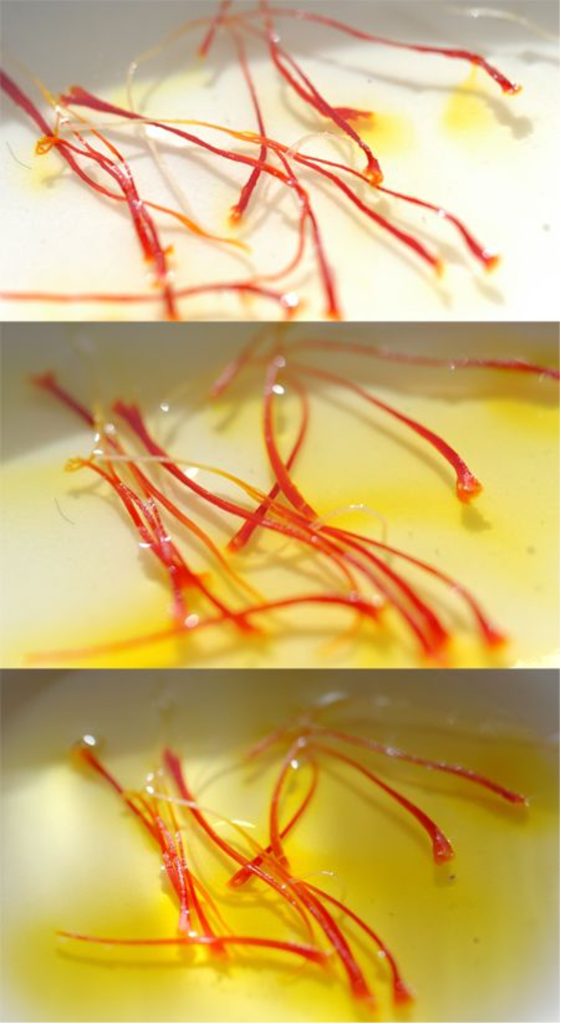
Best Ways To Know Real And Fake Saffron
For knowing real and fake saffron you must first know about the physical feature of this expensive spice. Freshly dried Saffron is glossy and greasy to touch, turning dull and brittle with age. It gets easily bleached if not stored in the dark and also stores better under conditions of low temperature and low relative humidity. The high price of this spice gives rise to frequent adulterations. Water is sometimes added in order to increase its weight. Oil or glycerin is also added for the same purpose or to improve the appearance. Sometimes the flowers of other plants are mixed with the genuine stigmas. High-quality saffron threads are typically fine and uniform in size. One end usually has a trumpet-like shape, while the other has a thin, tendril-like appearance. If you notice that the saffron is irregularly shaped, features shreds instead of strands, or contains bark, it’s probably inferior quality. If the threads have a frayed, almost worn appearance that can also be an indication that the saffron is of poor quality.
Distinguishing Between Real And Fake Saffron
Cold Water Test
Rub The Saffron Threads With Your Fingers
Test And Smell It
Testing Method
Saffron also is known as “Red Gold”, is the most luxurious spice in the world. When you decide to buy something expensive, knowing about an easy and reliable test to find out the originality of the product is very important. In most cases, saffron consumers are not able to distinguish original saffron from fake ones. But, don’t worry. Here, we will teach you some simple and fast methods of testing saffron purity.
COLD WATER TEST
Place a few saffron threads on top of a clear glass of cold water. Both pure and fake saffron will release some of their colors in the water, but the difference is in the quickness of it. Pure saffron will not release a lot of colors immediately. It will take around 10-15 minutes for the cup of water to turn completely yellow.
On the other hand, deep red color in the water instead of bright yellow color is a sign of adulterated Saffron which contains harmful coloring chemicals.
Another point is that the Saffron threads should not lose their red colors, fake saffron threads will turn white after a short period of time.




RUB THE SAFFRON THREADS WITH YOUR FINGERS
After infusing the Saffron threads in cold water for a few minutes, take a coupe thread and place them on your finger. Rub the threads with two fingers back and forth a few times. Pure Saffron threads will not break apart, whereas fake saffron will fall apart or turn to dust or liquid.
The first picture is real saffron, the second and third are fake saffron, and as you can see the second one is falling apart and the third one turns to dust and liquid.
This liquid is ready to add to a dish at any stage, but it is recommended to add most of the saffron-infused liquid early on and keep a few drops for a finishing touch.
TEST AND SMELL IT
Another way to check the quality of saffron is to place a thread of saffron in the mouth. Sweet saffron is FAKE Quality Saffron should smell sweet, but never taste Sweet! Actually, it tastes a bit bitter.
The smell of Pure Saffron reminds people of a mixture of honey and hay aroma. Sometimes the Saffron can have a sharp type of smell, this is due to high levels of Safranal and Picocrocin in the Saffron.

How Is Saffron Adulterated (Fake Saffron)?

Unfortunately, dishonest sellers are trying to make money on the popularity of saffron, by providing low-quality saffron or even completely fake saffron. They are doing this in a few different ways. For instance, some of them are using moisture to add weight. By adding a few mist sprays of water, this can add an additional 10-15% more weight to the product. So, make sure the Saffron you’re receiving isn’t moist, this is NOT an indication of fresh Saffron. Saffron should be dry and delicate, yet still contain a fresh aroma.

Also, some sellers sell an INDIAN flower as saffron because of the similarity of color, unfortunately, regular customers cannot understand easily. And also, adding corn silk and spray them with coloring chemicals to make it look like Saffron. We don’t have to talk much about the potentially harmful effects of this approach. Moreover, there are some sellers that are adding fillers like rice flour, sawdust, starch, and other fillers that are dangerous. These adulterated and fake versions of saffron are cheaper, but they are practically useless and potentially harmful.
